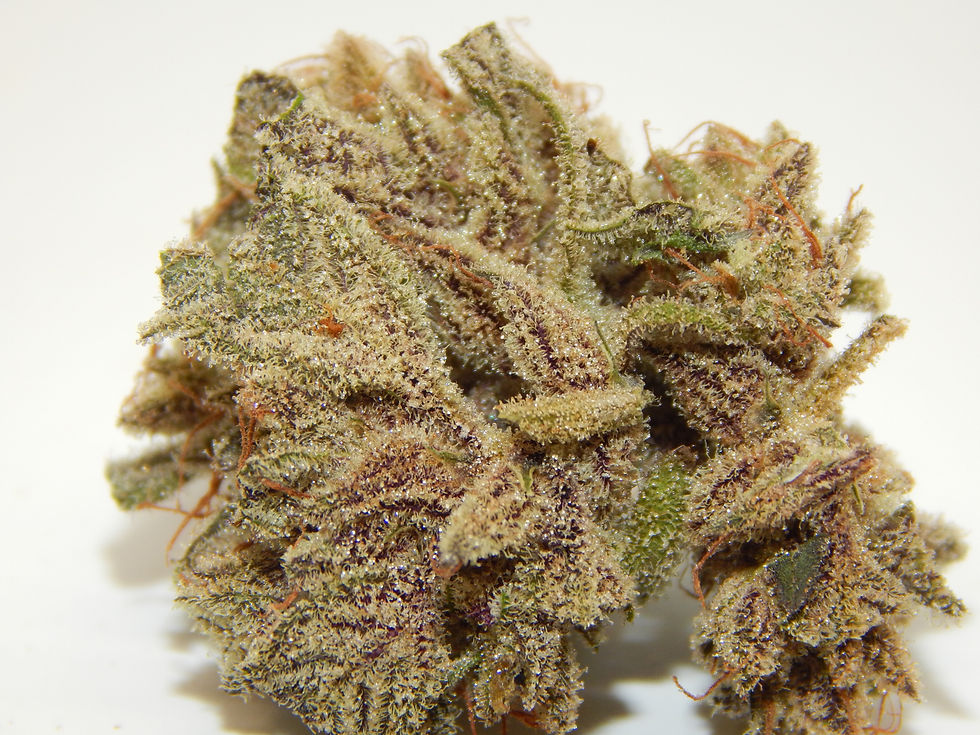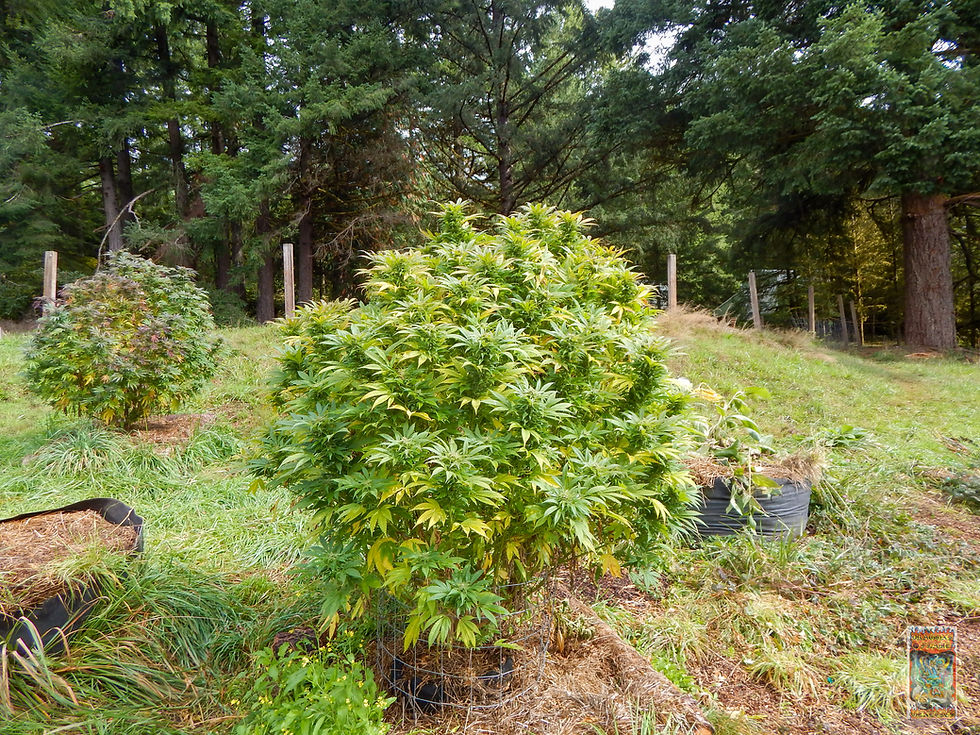Beautiful Colors of Cannabis
- Jeff
- Aug 22
- 5 min read

The Colors of Cannabis: What Brings Out Those Stunning Hues?
Walk into a cannabis garden near harvest and you might feel like you’ve stepped into an art gallery. Buds shimmer in deep purples, fiery oranges, golden yellows, and even midnight blues, framed by sugar leaves frosted with resin. For growers and consumers alike, these colors aren’t just eye candy—they’re a living showcase of the plant’s inner chemistry, genetics, and environment.
But how do these rainbow hues come about? Let’s break it down.
Chlorophyll: The Green Foundation
Every cannabis plant begins the same way—green. That’s thanks to chlorophyll, the pigment that fuels photosynthesis by capturing sunlight and converting it into energy.
In vegetative growth, chlorophyll dominates the plant’s palette.
It not only keeps the plant alive but also hides the subtler pigments beneath.
Think of chlorophyll as the blank green canvas upon which other colors eventually appear.

Anthocyanins: The Purple, Blue, and Red Spectrum
As plants mature, especially in late flower, chlorophyll production slows and other pigments step into the spotlight. One of the most dramatic is anthocyanin, a flavonoid found in blueberries, grapes, and red cabbage.
Anthocyanins can appear in different shades depending on pH:
Acidic conditions → Reds
Neutral conditions → Purples
Alkaline conditions → Blues
In cannabis, this is why strains like Granddaddy Purple, Blueberry, or Purple Kush look so striking—they’re genetically predisposed to produce high anthocyanin levels, and once chlorophyll fades, those hidden hues finally show through.

Carotenoids: The Sunset Tones
Another family of pigments—carotenoids—provides cannabis with its warm yellows, oranges, and golds. Carotenoids are also responsible for the color of carrots, squash, and fall leaves.
These pigments serve an important role in the plant:
They act like natural sunscreen, protecting tissues from intense light.
They assist in photosynthesis by capturing wavelengths that chlorophyll doesn’t.
When cannabis flowers start glowing in golden or orange hues, carotenoids are at work, balancing beauty with function.
Temperature and Seasonal Change: Nature’s Paintbrush
One of the biggest environmental triggers for color is temperature swing. Cool nights encourage the breakdown of chlorophyll, letting anthocyanins and carotenoids shine. That’s why outdoor-grown plants in autumn often show richer purples and blues compared to the same strain grown indoors under constant conditions.
But it’s not just temperature—other environmental stresses can play a role:
Nutrient adjustments (especially phosphorus)
Light intensity and spectrum
Drought or mild stress events
These factors can amplify pigment expression. To the plant, it’s part of adaptation. To the grower, it’s pure visual magic.

Genetics: The True Color Palette
While environment influences vibrancy, genetics set the stage. Not every strain will turn purple just because it’s grown in cooler weather. Some cultivars lack the genetic capacity to produce high anthocyanins and will stay green no matter what.
On the other hand, some strains seem determined to dazzle, regardless of conditions. Classics like Granddaddy Purple, purple Urkel, and Forbidden Fruit are almost guaranteed to show color, while strains like Sour Diesel or other Kush types tend to stay green with just a touch of yellowing late in flower.
Think of genetics as the paintbox, and the environment as the brushstroke that decides how vivid the final painting will be.
Do Colors Affect Effects?
This is the million-dollar question. While colors themselves don’t directly determine potency or flavor—that’s the job of cannabinoids and terpenes—pigments like anthocyanins and carotenoids may play subtle roles:
Antioxidant properties: These compounds can help the plant defend itself, and may contribute minor benefits to humans as well.
Entourage effect: Though research is still early, flavonoids (including anthocyanins) are thought to interact with cannabinoids and terpenes in ways we don’t fully understand yet.
At the very least, vibrant colors signal a healthy, mature flower, and they certainly add to the sensory experience. After all, we eat (and smoke) with our eyes first.

Cultural Meaning of Color in Cannabis
Beyond science, colors also carry cultural weight in cannabis. Purple strains in particular have become legendary in the community. In the early 2000s, “purple weed” was a symbol of top-shelf quality, partly because it was rare outside certain growing conditions. Today, breeders actively select for color expression, leading to an explosion of “designer” buds with rainbow-like appeal.
Whether it’s a deep-purple Granddaddy Purp, a lime-green Jack Herer, or a neon-orange Tangie, color has become part of cannabis identity, branding, and consumer expectation.
Grower’s Tips: How to Bring Out Color in Your Garden
If you’re cultivating cannabis and want to coax out those beautiful hues, here are some tried-and-true tips:
Choose the Right Genetics
Start with strains known for colorful expression
Remember: no amount of environmental tweaking can make a naturally green strain turn purple.
Play with Temperature
Lowering nighttime temps (ideally a 10–15°F drop) in late flower encourages chlorophyll breakdown.
Be careful not to stress your plants too much—avoid frost-level cold, which can damage buds.
Generally once you get under 60 degrees the soil and plant will start to shut down, so you don't want to overdo it either!
Dial in Nutrients
A balanced phosphorus supply supports anthocyanin expression.
Overfeeding nitrogen late in flower can keep plants green longer, muting potential colors.
Mind the pH
Anthocyanin expression shifts with pH—keeping your root zone slightly acidic to neutral may favor purples.
Always adjust carefully—wild pH swings can hurt overall plant health.
Light Spectrum
UV and full-spectrum lighting can enhance pigment production. Some growers supplement with UV-B in late flower for richer colors and resin.
Healthy Stress, Not Harmful Stress
Mild stress (cool nights, subtle drought cycles) can trigger color without hurting yield.
Severe stress (deficiencies, overfeeding, or light burn) risks plant health and cannabinoid output.
At the end of the day, the key is balance—don’t chase color at the expense of quality. A frosty green bud can smoke just as beautifully as a purple one, but when the two combine, that’s when the jar truly shines.

Closing Thoughts: Cannabis as Living Art
The next time you admire a colorful jar of flower, remember you’re seeing more than just decoration. You’re witnessing a collaboration between plant chemistry, genetics, and environment, creating a natural work of art.
Cannabis doesn’t just grow—it expresses itself, painting its own portrait through greens, purples, blues, and golds. And that’s part of what makes the plant so endlessly fascinating—not just to scientists and growers, but to anyone who’s ever stopped to appreciate the beauty of a bud.
Now, that we have the science out of the way, lets turn to some pretty examples of the paintbrush of colors that cannabis can show us!
Red Bulgarian Dragon - Old school unique and definitely capable to showing an array of colors.









Comments